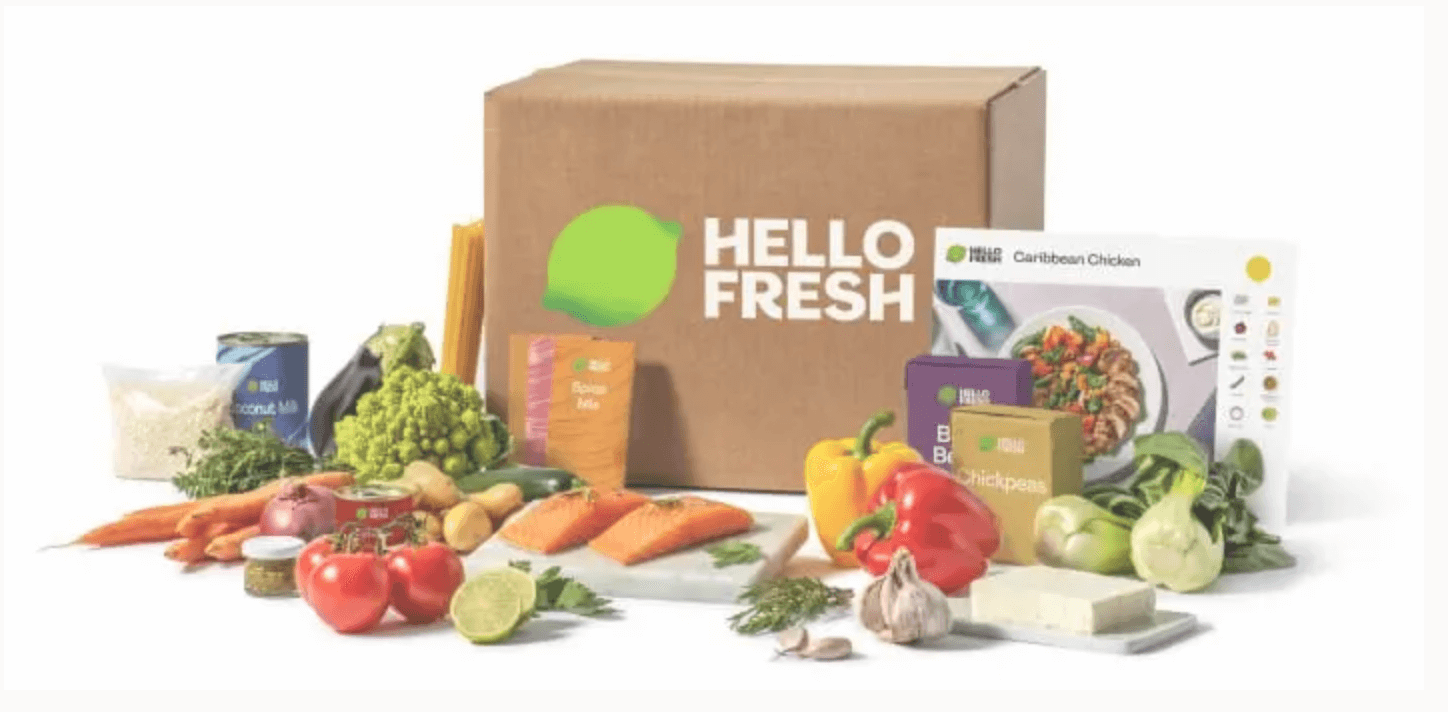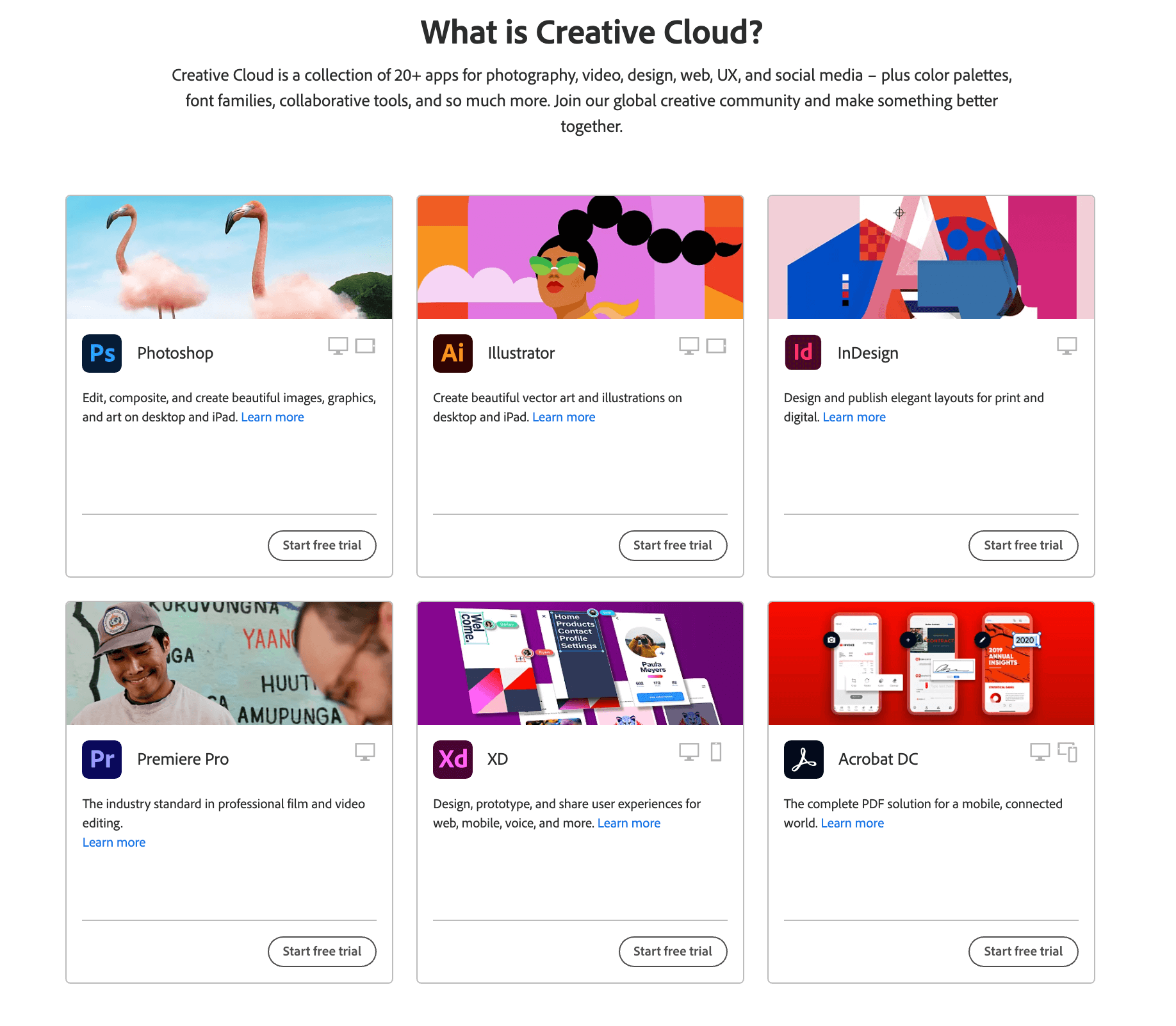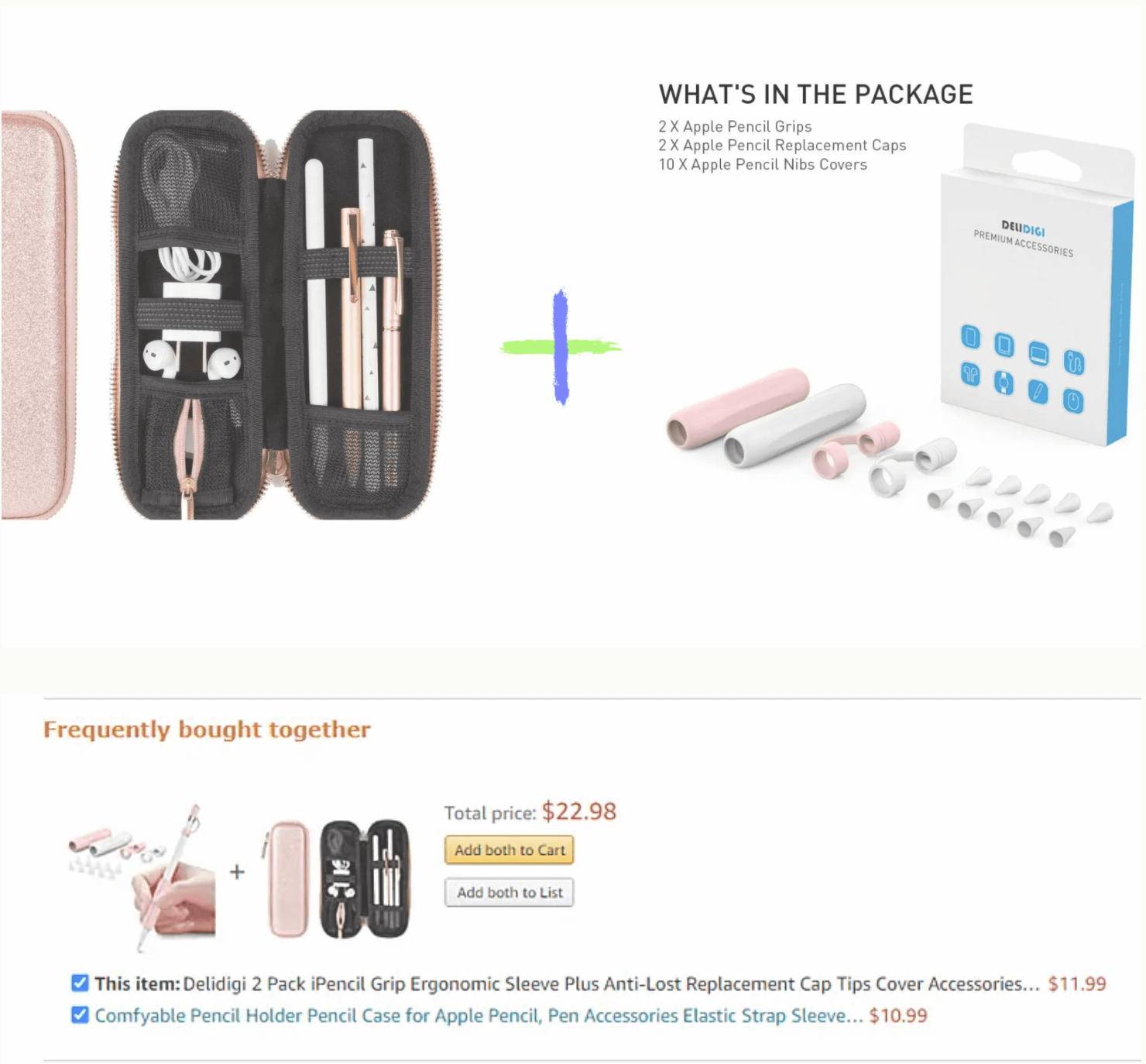What is product bundling?
Product bundling is when a business groups two or more products or services under one stock-keeping unit (SKU) code — referred to as a package or bundle. This marketing strategy encourages sales, cross-selling, and engages customers throughout the year.
The product bundles are sold either in-store — usually, somewhere that’s easily seen — or on e-commerce stores to help streamline purchases. Ultimately, this leads to more sales than offering goods separately and can help to maximise the ROI of poorly selling inventory.
Examples of common product bundling
From socks and underwear to software packages, there are lots of complementary products that can be sold as a product bundle. Here are a few examples:
- Flights and hotels: Going abroad? Why not book a flight and somewhere to stay at the same time? Online travel websites like Lastminute put the two together.
- Guitars and amps: If you’re buying an electric guitar, you’re going to need an amp. Most music stores will sell guitars and amps as packages.
- Meal deals: Combination meal deals — sandwiches, crisps, and drinks — make lunch easy for many of us in a rush.
- Razors and razor blades: You can’t use one without the other, and shops rely on the customer’s connection to purchase both to offer both at a reduced cost
- Shampoo and conditioner: After washing your hair, you need to condition it — so many retailers simply bundle the two products together.
- Hotels with breakfast included: Some hotels don’t include breakfast as standard, so customers can choose a bundle that includes breakfast at a reduced rate.
- Software with additional features: Lots of software developers sell base versions of their products with the option to add functionality as you go. This gives you complete control over what you get — and it’s often at a discount.
Why is it important to use product bundling in your marketing?
Why should organisations consider product bundling as a marketing strategy? The main reason is that it’s a win-win for both the business and the customer — but there are several others:
Create a positive impression of your brand
If an offer includes a discounted or free product, customers will see it as more of a bargain than if the two products were sold separately. By offering more bundles, you give your customers the best value for money whilst maximising your sales.
Get rid of excess stock or non-shifting products
Combining hard-to-sell products with popular ones can increase their chances of being purchased, rather than them becoming depreciating assets that take up space. This is a great approach for inventory clearance and management.
Save time and marketing costs
Bundling products means saving marketing time. The products can be sold as a package deal, meaning you’re marketing just one thing, not two, and it’s much easier (especially for physical products) for staff to stock. Another benefit is that rather than marketing two products, you market just the one.
Open customers up to new product lines
If your bundle contains items that customers have never tried before, this enables them to sample goods — and expose them to a whole new range of products.
Take advantage of seasonal opportunities
By product bundling at peak times throughout the year, like the holidays or during summer sales, you can create a sense of urgency or fear of missing out (FOMO) that encourages customers to buy, buy, buy.
Improve customer satisfaction
Customers want to feel appreciated and understood. For example, if you create bundles of products that work well together — and customers want them together — it shows that you understand their needs.
Sell more to customers
Bundles provide customers with more choices and better value, especially if the bundle contains products that they need. In most cases, customers are more likely to choose a well-made bundle over a product sold individually
Reduce shipping costs
Bundling items together, along with a discounted price, leads to lower overall shipping costs as you’re sending items in bulk.
For customers: Why product bundling is important
Get a better deal
Product bundles often come with a discount. If customers intend to purchase these products together anyway, bundles are the best way to go. Customers will also shop around to find the best discounts on the bundle as well.
Want to price your products for maximum profitability? Find out how.
Try out different products
With product bundles, customers get to try out new products or product ranges that they may not have tried before. For example, when purchasing make-up from a cosmetics store, customers are sometimes offered free or discounted products to try.
Reduce the amount of research
Product bundles bring together complementary solutions naturally. As such, customers don’t have to do any research to see if those products would work together. This speeds up the purchase process and provides a frictionless user experience.
Personalize orders
Customise bundles to suit requirements. By offering a degree of customisation, customers aren’t limited to predetermined options.
Advantages of product bundling
The benefits of using product bundling for businesses are:
- Companies can clear old inventory, sell unpopular products and reduce waste.
- Shorter decision-making processes, leading to faster sales cycles and increased customer average order value (AOV) levels.
- Financial value to the customer, helping businesses to attract new customers and ensure repeat business.
- Businesses can save money on marketing and distribution costs by bundling products.
Disadvantages of product bundling
The downsides of using product bundling for businesses are:
- The business or brand may suffer if customers only buy product bundles rather than individual products.
- If the bundle contains unpopular products or a very cheap item, customers may not want to purchase them, even if there is a discount. (The presenter’s paradox says customers unconsciously average the value of a bundle by the number of products, instead of the sum value of the products.)
- Customers always look for the best value. They’ll avoid paying for products at full price — where possible — and opt for bundles and discounts. If you don’t offer product bundles, you could end up lengthening your sales cycle.
In the next section, we’ll cover the types of product bundling strategies.
Types of product bundling
Pure bundling
Products in pure bundles are sold as a set. You can’t buy them individually. As a result, this limits how flexible the bundle is for the customer.
However, for limited edition or rare products in a bundle, customers may want to snap these up out of fear of missing out. For example, a limited edition goodie bag as part of a fashion show’s ticket price.
Hellofresh product bundling

HelloFresh is an online retailer of fresh ingredients sold as a bundle to consumers directly so that they can create healthy meals at home.
It is an example of pure bundling where all the ingredients are sold together, according to a recipe. As customers pick which recipes they want to make, they receive the appropriate ingredients and portions for them. They can’t purchase items individually.
Mixed bundling
Mixed bundles enable customers to buy specific products as a bundle or as individual items. For example, a customer can buy a single burger from a fast-food restaurant, or buy it as part of a bundle value meal.
Mix and match bundling
With a mix and match bundle, customers can choose multiple products from several options to get a tailored package. For example, choosing a six-pack doughnut bundle and specifying what flavours they want.
Adobe Creative Cloud product bundling

Software producer Adobe caters to its customers by selling software solutions individually, e.g. Photoshop and Illustrator, or as subscription bundles.
Customers that want all of the products in the Adobe Creative Cloud Suite — and already use Photoshop or Illustrator, for example, can then purchase the full product bundle at a reduced price.
Cross-sell bundling
Cross-sell bundling involves grouping complementary products from different product categories or vendors together. For example, along with the ticket, a music festival might include a t-shirt from one of the participating artists.
Amazon product bundling

Tech and e-commerce company Amazon has algorithms that suggest product bundles to a customer based on what they have bought in the past. These suggestions logically group products across category lines. For example, a BBQ kit, charcoal, and lighters.
New product bundling
Often, to increase the hype around the release of a new product, brands will create special launch bundles that are only available for a limited time — or limited in number.
For example, new console launches often include bundles containing the console and older (or newer) accessories.
Need a way to vet your product concepts? We’ve got you covered.
Gift set bundling
A lot of retailers have the option to create discounted gift bundles — along with wrapping services — during holiday periods. This approach encourages customers to add more items to their purchases.
For example, customers can purchase flowers but then add chocolates and a card to create a gift bundle.
BOGOF or half-price bundling (Buy one, get one free or half price)
Commonly used to clear inventory or upsell to customers, BOGOF bundling and half-price bundling are useful for encouraging customers to purchase a product or purchase at a discount.
This is particularly useful when customers are unsure of how many items they want to purchase or want to get a specific second item, but not at full price.
Old inventory or inventory clearout bundling
Want to shift old inventory or just clear things out to make space for seasonal items? This approach works wonders. Combine popular products with non-moving or old product stock to shift it quickly away from the business. This method helps to recoup costs, even with older products selling at a lower price.
Occasional bundling
This method makes the most of the holiday season and special occasions. During Valentine’s day, for example, you’ll often see a mix of flowers, cards, wine, and chocolates bundled together for people wanting to celebrate with their significant other.
Same-product bundling
Similar to bulk purchasing, this method benefits customers who want to purchase a lot of something upfront. Think soap, air fresheners, candles, batteries, and so on. Typically, this method is for goods that exhaust quickly.
How to properly sell these new product bundles
In this section, we’ll look at the strategies and methods for selling product bundles, as well as what metrics to use to measure success.
Understand who your customer is
What do you know about your customer? While you may already have information on your customers in your CRM system, including past sales and purchase behavior, what makes them purchase specific products? Look at what they buy together and when (seasonality), as well as the products they don’t purchase (those left in the shopping cart and abandoned). Once you understand purchase behaviour, you can start to create tailored product bundles and strategies.
Create data-driven bundles
What are your customers buying frequently? And what can you pair together, based on data, to meet their expectations?
Look at what complementary products you can sell together from your range, and choose appealing options for customers. Lastly, create diverse product bundles so that there’s something for everyone. Your bundles should contain products that your customers have purchased and are likely to need again, as this ensures repeat revenue rather than one-off sales.
Offer small discounts
Customers are always looking for the best value. This means they’ll shop around for discounts and offers. To enhance your sales, consider applying a discount to your bundles. This will make your products much more appealing without hampering your profit margins.
Learn how to create more innovative, experience-led products
Choose a product bundling strategy
How can you help your products shine? Here are some examples of product bundling strategies that bring your bundles’ value to the forefront:
- Price anchoring or ‘buy more pay less’: Spreading the cost of a product bundle by using a monthly payment plan can make the bundle seem cheaper to purchase.
- Categorical thinking or reasoning: Showcasing the benefits of the product bundle over the cost can help the customer focus on reasons to purchase.
- Time-limited bundles: Creating a sense of urgency can increase the likelihood to purchase. This could be as part of a limited edition offering or seasonal product for the holidays.
- Put bundles at key display areas: Strategic placement of your product bundles, e.g. near the till or at the entrance, can help encourage ‘quick decision’ purchases. In brick and mortar stores, as well as online, promote bundles in places or web pages your customers frequently visit.
- Recommendations: Take advantage of customer referral marketing to promote your product bundles to other customers. It’s far less biased and much more authentic.
- Bundle products by theme: If products are usually bought together, customers are more likely to buy them as a bundle. The bundle should, therefore, make sense to the customer — e.g. toothbrushes with toothpaste, deodorant with antiperspirant.
- Show off the savings: When marketing your bundles, explain how much customers are saving as a result. This will appeal to more cost-conscious customers.
- Consider personalisation for bundling: Use your customer data to personalise bundles — customers love tailored products and services!
Collect the right metrics
The below metrics will help you to measure the performance of your product bundling strategies:
Top and bottom performing product bundles
Rank your bundles based on the highest and lowest performance in terms of sales.
Average order value (AOV)
Is your AOV per customer steadily increasing? Find out what bundles these customers are buying and why.
Annual growth of a product
By looking at the sales record of an item over a year, you can see if it’s performing well as a solo item. If not, consider bundling it with a high-performance product and monitor the results.
Comparing sales and positive reception
How are bundles being received across your brand or business? Does seasonality affect the popularity of some bundles more than others? Compare performance across product lines to determine if you should continue bundling items or sell them separately. Maybe there are complimentary items or themes that you can capitalise on during certain seasons.
Have the right system in place to manage analytics and decisions
Product bundling has been a great marketing strategy across every sector and continues to happen every day online and in-store, so if you sell products or services it’s worth thinking about how you incorporate this into your sales and marketing planning.
Of course, a key challenge with any product is not only ensuring that it’s successful but managing that success long term.
Great products are at the core of every successful business — but how can you identify what your customers want and how can you maximise the value of what you deliver for them?
In our eBook, on maximising product success, we explore how product research helps you to make the most crucial decisions with confidence — from generating an idea and finding the right price, to incorporating new features and knowing when to retire your products.
Maximise your product's success